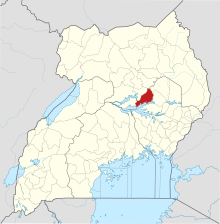| This article includes a list of general references, but it lacks sufficient corresponding inline citations. Please help to improve this article by introducing more precise citations. (August 2017) (Learn how and when to remove this message) |

The Kumam people are part of a Hamites ethnic group of about 720,000 census 2024, living mainly Kumam Sub-Region of Kaberamaido, Soroti, Soroti City, Kalaki, parts of Serere, Dokolo and Amolatar respectively in the western areas of Teso sub-region and the south-east of Lango sub-region. The Kumam are an ethnic group of people found in Kaberamaido, Soroti, Kalaki, Dokolo, Amolatar districts and the Lake Kyoga Basin Area in Eastern Uganda. They share Soroti district with the Iteso and some parts of formerly Lira district with the Langi. In the Lango region, they are now found in Dokolo district which was detached from Lira District. They are found at the shores of Lake Kyoga (Namasale). In Soroti district, they are found in Serere, Asuret, Kamuda, katine, Soroti city, Arapai as well as the outskirts of Soroti district neighboring Kaberamaido.
They speak Kumam language similar to the language spoken by the Lango, with some Ateso vocabulary.
Origin
The Kumam descend from the early fishing, agricultural, and herding communities of Ethiopia in 1560 AD or there about. Who migrated southwards towards Uganda because of land pressure around the 17th century. Today, they live on the shores of Lake Kyoga in the districts of Serere, Soroti and Kaberamaido
Kumam traditions say are part of the Iteso people. They probably lost part of their original Leno Dialect similar Dialect from Ethiopian Oromo region Ateker language and adopted some words from the Western Nilotic Luo spoken by their Lango neighbours who are also Hamaties| Hamatic People although the speak a lanaguage almost understandable by the Acholi neighbours – due to prolonged contact and intermarriages. The Kumam must have preceded the ITeso in migration and settled in Soroti later hence, the Karimojong people from whom Iteso came know Soroti by the name 'Solot' and not teso.This points to the possibility of a later migration after iteso from Karamoja.
Culture and customs
Political set-up
The Kumam had political structure under clan leaders known as wegi Atekerin. Other people of importance in the society were wegi ikodeta Cel (leaders of dancing groups), and leaders of Asonya(ancient) homes, wegi Cel. The wegi Cel were in most cases Dogolan or Odonge ikekoros (heads of part of a clan descending form one man). These clan leaders were responsible for the maintenance of law and order as well as general administration. They arbitrated in matters of politics and social affairs. However currently the Kumam have transformed into a cultural chiefdom under the keadership of His Royal Highness HRH "Won Ateker" Papa Kumam who is the supreme cultural leader of the Kumam people. He is elected from among the "Wegi Ibukui" or Clan Leaders of the different clans. The Wegi Ibukui together with the council of Elders Wegi Etok Me Kumam constitute the powerful Kumam cultural heritage or Etok me Kumam. The Kumam also have a cabinet appointed by HRH won Ateker Papa Kumam to oversee and manage the activities of the Cultural Institution - Etok Me Kumam on his behalf with a number of ministers, deputy prime ministers and prime minister.
Social set-up
Music, dance and story telling played a big part in kumam lifestyle. At any time music would be made, at various functions, such as ceremonial, religious and political functions. In the evening, the old people would narrate stories to the younger generation as part of the oral traditions.
Marriage
Previously, the parents would arrange marriages for their children. Girls would be betrothed to boys at an early age. In effect, the young girl would become wife to a respective boy but she would wait to be officially handed over when she came of age. In some cases, the young girls so betrothed would be taken to the boy's home to grow up there. When she came of age, a ceremony would be organized to formalize the relationship. With time however the system changed. Today, the boy goes looking for a girl and without the consent of the parents and sneak with her to his home at night. After a week or so, the girl's relatives would begin to look for her. Obviously they had some prior knowledge of her whereabouts. On discovery, a fine would be exacted from the boy. Arrangements would be made to settle the bride wealth and the marriage would be formalized.
See also
References
- ^ "Kumam in search of cultural autonomy". Daily Monitor. Retrieved 2020-05-30.
- ^ Uzoigwe, G. N. The beginnings of Lango society : a review of evidence. OCLC 38562622.
- ^ Angola, Geofrey. "A history of the Iteso clans, a case study of Irarak clan of Kasilo County, Soroti district in Eastern Uganda 1900-1962. Makerere University Library: Makerere University. p. 6.
- "The Kumam People of Uganda — A Cultural Profile". orvillejenkins.com. Retrieved 2024-02-13.
- ^ Olyech, Erimayo (1936). The anointing of clan heads among the Lango. Makerere University Library: The Uganda Journal.
- ^ Tribal names and customs in Teso district, Kagolo (1955). B M. Makerere University: The Uganda Journal.
- "The Details of the Kumam People and their Culture in Uganda". Go Visit Kenya. Retrieved 2024-02-13.
- Refer to the Ugandan Journal Vol II, No 2 of 1947 , "Notes on the KUMAM" by Reverend Father C.I Walshe of the Catholica Mission (Mill Hill Fathers), Lwala in Kalaki. https://original-ufdc.uflib.ufl.edu/UF00080855/00026/49j. Also Refer to "Kumam ikare me Asonya" by I.E Ekadu, 1961 Makerere University
- ^ Odada, M. A. E (1971). The Kumam: Langi or lteso?. National Library of Uganda: The Uganda Journal.
External links
| Ethnic groups in Uganda | |
|---|---|